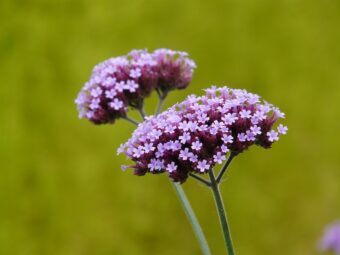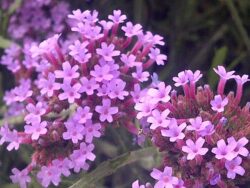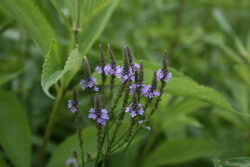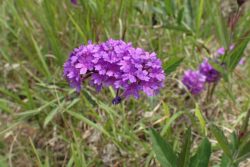In this article, we will discuss how to grow the firm favourite summer bedding plant of Verbena in containers. They are plants that will attract pollinators with their rich nectar blooms produced all summer long. You will short varieties more suitable as part of container summer display schemes or you have Verbena bonariensis, a hardy verbena that can be grown as a sole specimen in containers, they do well in the ground and do well in containers.

The leaves are small and velvety green but this is nothing to the mass of white, blue, purple, pink and red blooms produced by the plant all summer long. They tend to blend well with other commonly used summer bedding plants. They are easy to grow from seed or if you are not that green-fingered, you can grow them from shop-bought, garden-ready plants.
HOW TO GROW VERBENAS IN CONTAINERS
As said earlier, you have a choice on how to grow your verbenas; either from seed or from garden-ready plants. If you are planning to grow from seed, sow them anytime from March to April. You can plant them out in late May after the late frosts have passed. You will need to harden the plants before planting outside.
To grow from seed, fill a seed tray with seed sowing compost. Water it well and allow the excess to drain away. On top of the surface, sprinkle the seeds lightly on top. Check the package before covering with more sieved seed compost, as some will need light to germinate whilst others will need a thin covering to germinate. Place a propagator lid on top and place it on a warm sunny windowsill.
Once the seedlings have emerged and have become large enough to handle, then you can prick them out into a 15 -cell tray full of multipurpose compost. Allow them to grow on before hardening off and planting in containers in late May.
If you have bought verbena as small plug plants then you will need to pot them on in 7.5cm pots full of multipurpose compost. Do this indoors or in a greenhouse, as they cannot take frosts. Plant out in late May after the usual hardening off. At this stage, seed reared plants, plug plants that have grown on and shop-bought plants can be treated in exactly the same way.
PLANTING IN CONTAINERS
Select a medium-sized container, making sure that it has plenty of drainage holes. The container size must be big enough for the display in question or if you want to grow colourful displays of verbenas, then use 3 plants as a minimum.

Fill the container with good quality, multipurpose compost to near the top. Dig holes slightly bigger than the root ball of the original container at equidistant from each other and at least 15cm between them. Drop the plant in so that the top of the root ball is at the same level as the top of the surface of the compost. Backfill with the growing media, ensuring that any gaps are filled with additional multipurpose compost. Firm the plant in and water well.
Place the verbena in a sunny location, where it will need little attention when the plants are well established. Water well when heatwaves occur and feed every 2 weeks with a high potash fertilizer when the plant is in flower.
The perennials can self-seed everywhere, so new plants are readily available for propagation for additional plants. The half-hardy perennials can survive warm winters but this is a gamble, so be prepared for losses. The tall varieties will not need to be gained as the wiry stems are sturdy enough to support themselves.
One task that must be carried out is deadheading for certain varieties to continue to produce blooms, whilst many will continue for many months until the first frost shit in autumn. Once the tall varieties have died back in early spring, you can cut them back down to the ground. The seed heads will provide winter food for wildlife, so do not be too hesitant to chop them down after flowering.
PESTS AND DISEASES

They tend to be pest and disease-free, but tender Verbenas are susceptible to powdery mildew, especially so if started off in a greenhouse. A white coating will often appear on the surface of the leaves that ruin its look. Best to improve the air circulation around the plants, removing affected leaves and watering at the roots to avoid it from happening in the first place.
Aphids, thrips and leafhoppers can be a problem and are best dealt with by spraying jets of water or by using a suitable systemic insecticide.
VARIETIES TO GROW
There are many verbenas that can be grown in containers, including the familiar Verbena bonariensis that produces large clusters of lavender flower heads on tall, stiff, upright stems. One variety of Verbena bonariensis to grow is ‘Buenos Aires’. A dwarf variety of Verbena bonariensis ‘Lollipop’ that produces the same cluster of purple flowers but in 60cm tall stems.
The familiar bedding type is Verbena x hybrid that is divided into upright and mount-forming. ‘Quartz Mix’ flowers with all colours imaginable from reds, whites and purples.

‘Scentsation Mixed’ is a new variety that is compact and has colours in whites and pastel blues and is wonderfully scented. ‘St George’ produces masses of stunning red and white flowers.
‘Union Jack Mixed’ produces trailing stems with red, white and blue flowers. Great if you want to make a Union Jack display.
‘Drum Purple Red’ is a variety of pinkish-purple flowers with inner petals that are bright red. It produces flowers prolifically throughout the summer months.
‘Peaches ‘n’ Cream’ produces salmon-orange flowers that fade to apricot and then creamy-yellow over time. Great in hanging baskets.
‘Vectura Purple’ on round clusters produces purple flowers on top of lobed leaves that appear early on the growing season. A similar variety that produces white flowers is ‘Vectura White’.
‘Samira Pink King’ produces bright pink blooms with each flower having a contrasting white centre.
Verbena hastata ‘Blue Spires’ is a hardy perennial that produced tiny blue flowers throughout the summer months. An eye-catching species of Verbena. Another variety is ‘Pink Spires’ that produces pink flowers.
Verbena rigida produces 60cm tall purple flower spikes that are fragrant.
CONCLUSIONS
In this article, we have discussed how to grow Verbenas in containers. They are such wonderful plants, either the compact bedding plants or the tall, hardy perennials that can be grown as a sole specimen in containers. The annuals are more colourful but the tall perennials are more eye-catching,
They are easy to look after, easy to care for and are so pretty to look at. What more can you ask for.
If you have any questions or comments that you wish to make on growing verbenas in containers, please do so in the comment box below.
Happy Verbena growing.
